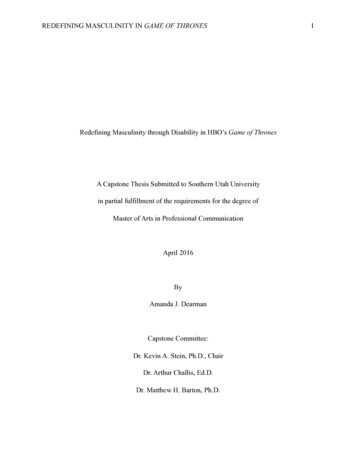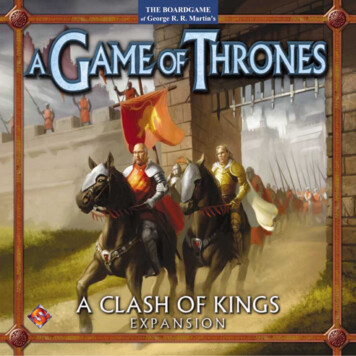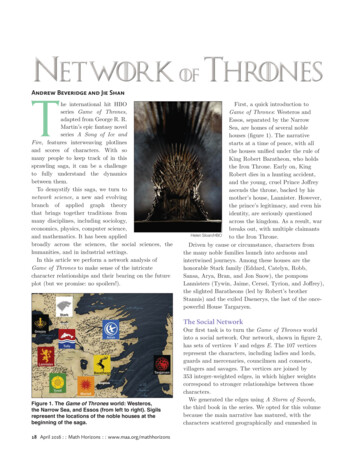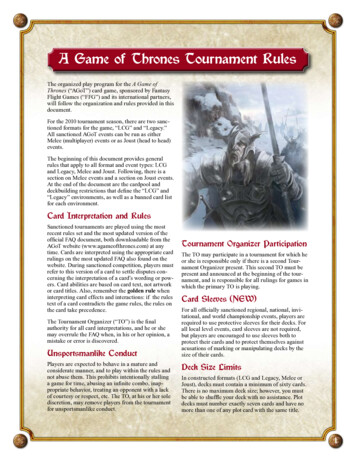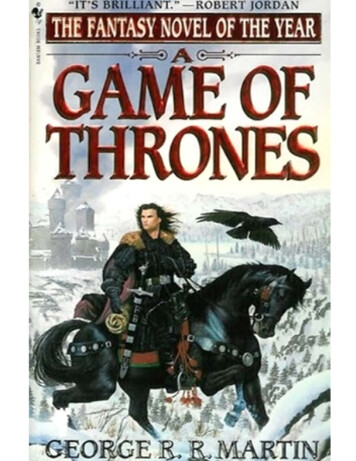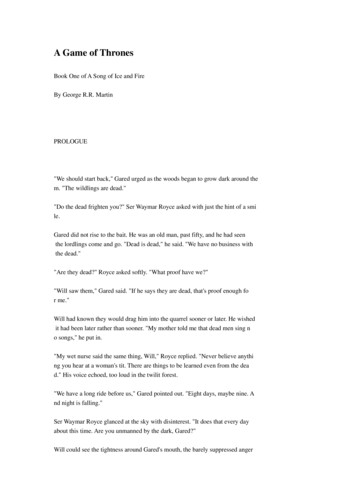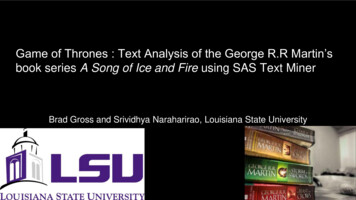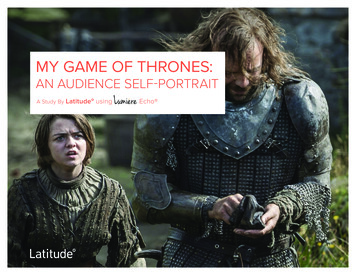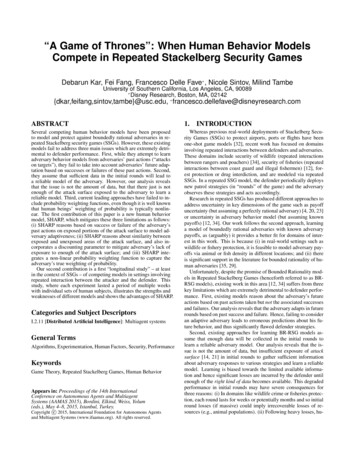
Transcription
“A Game of Thrones”: When Human Behavior ModelsCompete in Repeated Stackelberg Security GamesDebarun Kar, Fei Fang, Francesco Delle Fave , Nicole Sintov, Milind TambeUniversity of Southern California, Los Angeles, CA, 90089 Disney Research, Boston, MA, 02142{dkar,feifang,sintov,tambe}@usc.edu, veral competing human behavior models have been proposedto model and protect against boundedly rational adversaries in repeated Stackelberg security games (SSGs). However, these existingmodels fail to address three main issues which are extremely detrimental to defender performance. First, while they attempt to learnadversary behavior models from adversaries’ past actions (“attackson targets”), they fail to take into account adversaries’ future adaptation based on successes or failures of these past actions. Second,they assume that sufficient data in the initial rounds will lead toa reliable model of the adversary. However, our analysis revealsthat the issue is not the amount of data, but that there just is notenough of the attack surface exposed to the adversary to learn areliable model. Third, current leading approaches have failed to include probability weighting functions, even though it is well knownthat human beings’ weighting of probability is typically nonlinear. The first contribution of this paper is a new human behaviormodel, SHARP, which mitigates these three limitations as follows:(i) SHARP reasons based on success or failure of the adversary’spast actions on exposed portions of the attack surface to model adversary adaptiveness; (ii) SHARP reasons about similarity betweenexposed and unexposed areas of the attack surface, and also incorporates a discounting parameter to mitigate adversary’s lack ofexposure to enough of the attack surface; and (iii) SHARP integrates a non-linear probability weighting function to capture theadversary’s true weighting of probability.Our second contribution is a first “longitudinal study” – at leastin the context of SSGs – of competing models in settings involvingrepeated interaction between the attacker and the defender. Thisstudy, where each experiment lasted a period of multiple weekswith individual sets of human subjects, illustrates the strengths andweaknesses of different models and shows the advantages of SHARP.Whereas previous real-world deployments of Stackelberg Security Games (SSGs) to protect airports, ports or flights have beenone-shot game models [32], recent work has focused on domainsinvolving repeated interactions between defenders and adversaries.These domains include security of wildlife (repeated interactionsbetween rangers and poachers) [34], security of fisheries (repeatedinteractions between coast guard and illegal fishermen) [12], forest protection or drug interdiction, and are modeled via repeatedSSGs. In a repeated SSG model, the defender periodically deploysnew patrol strategies (in “rounds” of the game) and the adversaryobserves these strategies and acts accordingly.Research in repeated SSGs has produced different approaches toaddress uncertainty in key dimensions of the game such as payoffuncertainty (but assuming a perfectly rational adversary) [4, 20, 23]or uncertainty in adversary behavior model (but assuming knownpayoffs) [12, 34]. Our work follows the second approach, learninga model of boundedly rational adversaries with known adversarypayoffs, as (arguably) it provides a better fit for domains of interest in this work. This is because (i) in real-world settings such aswildlife or fishery protection, it is feasible to model adversary payoffs via animal or fish density in different locations; and (ii) thereis significant support in the literature for bounded rationality of human adversaries [35, 29].Unfortunately, despite the promise of Bounded Rationality models in Repeated Stackelberg Games (henceforth referred to as BRRSG models), existing work in this area [12, 34] suffers from threekey limitations which are extremely detrimental to defender performance. First, existing models reason about the adversary’s futureactions based on past actions taken but not the associated successesand failures. Our analysis reveals that the adversary adapts in futurerounds based on past success and failure. Hence, failing to consideran adaptive adversary leads to erroneous predictions about his future behavior, and thus significantly flawed defender strategies.Second, existing approaches for learning BR-RSG models assume that enough data will be collected in the initial rounds tolearn a reliable adversary model. Our analysis reveals that the issue is not the amount of data, but insufficient exposure of attacksurface [14, 21] in initial rounds to gather sufficient informationabout adversary responses to various strategies and learn a reliablemodel. Learning is biased towards the limited available information and hence significant losses are incurred by the defender untilenough of the right kind of data becomes available. This degradedperformance in initial rounds may have severe consequences forthree reasons: (i) In domains like wildlife crime or fisheries protection, each round lasts for weeks or potentially months and so initialround losses (if massive) could imply irrecoverable losses of resources (e.g., animal populations). (ii) Following heavy losses, hu-Categories and Subject DescriptorsI.2.11 [Distributed Artificial Intelligence]: Multiagent systemsGeneral TermsAlgorithms, Experimentation, Human Factors, Security, PerformanceKeywordsGame Theory, Repeated Stackelberg Games, Human BehaviorAppears in: Proceedings of the 14th InternationalConference on Autonomous Agents and MultiagentSystems (AAMAS 2015), Bordini, Elkind, Weiss, Yolum(eds.), May 4–8, 2015, Istanbul, Turkey.Copyright c 2015, International Foundation for Autonomous Agentsand Multiagent Systems (www.ifaamas.org). All rights reserved.INTRODUCTION
man defenders may lose confidence in recommendations providedby the game-theoretic approach. (iii) Given the nature of these domains, re-initialization of the game may periodically be necessaryand thus initial rounds may be repeated; in domains such as wildlifecrime, re-initialization can stem from man-made or natural changesin parks, e.g., changes in vegetation, water bodies, or possible developmental activities. The construction of an oil-refinery [1] andthe simultaneous re-introduction of rhinos in the Murchison FallsNational Park in Uganda is an example. In addition, re-initializingthe game after a year or so would mean repeating the initial roundsafter four to five rounds, adding to the importance of addressinginitial rounds.Finally, BR-RSG models have failed to include probability weighting functions (how humans “perceive” probabilities), even thoughit is well known that probability weighting curves for humans –e.g., in prospect theory [33] – are typically nonlinear. In light ofthis, we show that direct application of existing models such asSUQR [29] which assume a linear probability model, provide results that would be extremely detrimental to defender performance.The primary contribution of this paper is a new model calledSHARP (Stochastic Human behavior model with AttRactivenessand Probability weighting) that mitigates these three limitations: (i)Modeling the adversary’s adaptive decision making process, SHARPreasons based on success or failure of the adversary’s past actionson exposed portions of the attack surface. (ii) Addressing limited exposure to significant portions of the attack surface in initial rounds, SHARP reasons about similarity between exposed andunexposed areas of the attack surface, and also incorporates a discounting parameter to mitigate adversary’s lack of exposure to enoughof the attack surface. (iii) Addressing shortcomings of probabilityweighting functions, we incorporate a two parameter probabilityweighting function in existing human behavior models.Our second contribution is to provide evidence from the first“longitudinal study” of competing models in repeated SSGs. Inour study, a suite of well-established models and SHARP take thebattlefield (much like the warring factions in “A Game of Thrones”who are fighting for supremacy) in an attempt to prove themselvesbest in repeated SSGs. Our results show: (i) SHARP outperformsexisting approaches consistently over all rounds, most notably ininitial rounds. (ii) As discussed earlier, existing approaches perform poorly in initial rounds with some performing poorly throughout all rounds. (iii) Surprisingly, simpler models which were originally proposed for single-shot games performed better than recent advances which are geared specifically towards addressing repeated SSGs. Taken together, given the critical importance of therepeated ‘initial rounds’ as discussed above, these results indicatethat SHARP should be the model of choice in repeated SSGs.2.2.1BACKGROUNDBackground on SSGsIn an SSG, the defender plays the role of a leader who protectsa set of targets from the adversary, who acts as the follower [5,30, 18]. The defender’s pure strategy is an assignment of a limitednumber of security resources M to the set of targets T . An assignment of a resource to a target is also referred to as covering a target.A defender’s mixed-strategy x (0 xi 1; xi , i T ) is thendefined as a probability distribution over the set of all possible purestrategies. A pure strategy of an adversary is defined as attackinga single target. The adversary receives a reward Ria for selecting iif it is not covered and a penalty Pia for selecting i if it is covered.Similarly, the defender receives a reward Rid for covering i if it isselected by the adversary and penalty Pid for not covering i if it isselected. Then, utility for the defender for protecting target i whileplaying mixed strategy x is:Uid (x) xi Rid (1 xi )Pid(1)Similarly, the utility for the adversary for attacking target i is:Uia (x) (1 xi )Ria xi Pia(2)Recent work has focused on modeling boundedly rational adversaries in SSGs, developing models discussed below.Subjective Utility Quantal Response (SUQR): SUQR [29] buildsupon prior work on quantal response [25] according to which ratherthan strictly maximizing utility, an adversary stochastically choosesto attack targets, i.e., the adversary attacks a target with higher expected utility with a higher probability. SUQR proposes a new utility function called Subjective Utility, which is a linear combinationof key features that are considered to be the most important in eachadversary decision-making step. Nguyen et al. [29] experimentedwith three features: defender’s coverage probability, adversary’sreward and penalty at each target. According to this model, theprobability that the adversary will attack target i is given by:aeSUi (x)qi (ω x) P SU a (x)e j(3)j Twhere SUia (x) is the Subjective Utility of an adversary for attacking target i when defender employs strategy x and is given by:SUia (x) ω1 xi ω2 Ria ω3 Pia(4)The vector ω (ω1 , ω2 , ω3 ) encodes information about the adversary’s behavior and each component of ω indicates the relative importance the adversary gives to each attribute in the decision making process. The weights are computed by performing MaximumLikelihood Estimation (MLE) on available attack data.Bayesian SUQR: SUQR assumes that there is a homogeneous population of adversaries, i.e., a single ω is used to represent an adversary in [29]. However, in the real-world we face heterogeneouspopulations. Therefore Bayesian SUQR is proposed to learn a particular value of ω for each attack [34]. Protection Assistant forWildlife Security (PAWS) is an application which was originallycreated using Bayesian SUQR.Robust SUQR: Robust SUQR [12] combines data-driven learningand robust optimization to address settings where not enough datais available to provide a reasonable hypothesis about the distribution of ω. It computes the worst-case expected utility over all previously seen SUQR models of the adversary and deploys the optimalstrategy against the adversary type that reduces the defender’s utility the most. Robust SUQR has been applied to fisheries protectiondomain[12].2.2Probability Weighting FunctionsProbability weighting functions model human perceptions of probability. Perhaps the most notable is the weighting function in nobelprize winning work on Prospect Theory [17, 33], which suggeststhat people weigh probability non-uniformly, as shown in Fig. 1.It indicates that people tend to overweigh low probabilities and underweigh high probabilities. Other works in this domain proposeand experiment with parametric models which capture both inverseS-shaped as well as S-shaped probability curves [2, 10] (Fig. 2).3.RELATED WORKWe have already discussed related work in SSGs in the previoussection, including key behavioral models. Here we discuss additional related work:
Figure 1: Probability Weighting Figure 2: Probability WeightingFunction (Prospect Theory)Function (Gonzalez & Wu, 99)Learning in repeated Stackelberg games: The problem of learning the adversary’s payoffs in an SSG by launching a minimumnumber of games against a perfectly rational adversary is studiedin [20, 4]. Additionally, Marecki et al. [23] focused on optimizing the defender’s overall utility during the learning process whenfaced with a perfectly rational adversary with unknown payoffs.Robust strategies in repeated games: In cases where the opponent cannot be successfully modeled, McCracken et al. [24] proposed techniques to generate -safe strategies which bound the lossfrom a safe value by . Johanson et al. [16, 15] studied the problem of generating robust strategies in a repeated zero-sum gamewhile exploiting the tendency in the adversary’s decision makingand evaluated their technique in a game of two-player, Limit TexasHold’em. Recently, Ponsen et al. [31] proposed techniques to compute robust best responses in partially observable stochastic gamesusing sampling methods.All of the above work differs from ours in three ways: (i) They donot model bounded rationality in human behavior; (ii) They do notconsider how humans weigh probabilities; and (ii) None of theseexisting work address the important problem of significant initialround losses. Initial round losses is a critical problem in domainssuch as wildlife security as explained above; requiring a fundamental shift at least in the learning paradigm for SSGs. In addition,work on learning in SSGs differ because in our game, the payoffsare known but we are faced with boundedly rational adversarieswhose parameters in their behavioral model are to be learned.4.WILDLIFE POACHING GAMEWe conducted longitudinal experiments1 [22] with human subjects to test the effectiveness of existing behavioral models and algorithms against our proposed approach on repeated SSGs.4.1Game OverviewIn our game, human subjects play the role of poachers looking toplace a snare to hunt a hippopotamus in a protected park. The gameinterface is shown in Fig. 3. In the game, the portion of the parkshown in the map is divided into a 5*5 grid, i.e. 25 distinct cells.Overlaid on the Google Maps view of the park is a heat-map, whichrepresents the rangers’ mixed strategy x — a cell i with higher coverage probability xi is shown more in red, while a cell with lowercoverage probability is shown more in green. As the subjects playthe game, they are given the following detailed information: Ria ,Pia and xi for each target i. However, they do not know the purestrategy that will be played by the rangers, which is drawn randomly from mixed strategy x shown on the game interface. Thus,we model the real-world situation that poachers have knowledgeof past pattern of ranger deployment but not the exact location ofranger patrols when they set out to lay snares. In our game, there1Whereas “longitudinal study” is often used to describe research that spans years – inwhich measurement occasions are conducted every X years – we use the term longitudinal study because our study included 5 measurement points with a single population.Figure 3: Game Interface for our simulated online repeated SSG (Reward, penalty and coverage probability for a selected cell are shown)were M 9 rangers protecting this park, with each ranger protecting one grid cell. Therefore, at any point in time, only 9 out of the25 distinct regions in the park are protected.In addition to animal density, which is strongly correlated withhigh-risk areas of poaching [28, 27, 11], distance is another important factor in poaching, e.g., recent snare-density studies havefound that significant poaching happens within 5 kilometers of SouthAfrica’s Kruger National Park border [19]. Therefore, the rewardobtained by a poacher in successfully placing a snare at target iis calculated by discounting the animal density by a factor of thedistance traveled and is calculated as follows:Di)(5)Ria int(φi ζ max(Dj )jHere, φi and Di refer to the animal density at target i and the distance to target i from the poacher’s starting location respectively.int(y) rounds the value y to the closest integer value. The parameter ζ is the importance given to the distance factor in the rewardcomputation and may vary based on the domain. When the poachersuccessfully poaches, he may thus obtain a reward that is less thanthe animal density (Eqn. 5), but the defender loses a value equal tothat of the animal density, i.e., the game is non-zero-sum.4.2Experimental ProceduresWe recruited human subjects on Amazon Mechanical Turk (AMT).We first primed participants with a background story about thehardships of a poacher’s life. To enhance understanding of thegame, participants played two trial games, one validation game,and finally the actual game. Data from subjects who played thevalidation game incorrectly were discarded.We tested a set of behavioral models introduced in Section 2.1by deploying the mixed strategy generated based on each of thesemodels repeatedly over a set of five rounds. For each model, werecruited a new set of participants to eliminate any learning bias.Due to unavailability of data, the strategy shown for each first roundwas Maximin. We then learned the model parameters based onprevious rounds’ data, recomputed and redeployed strategies, andasked the same players to play again in the subsequent rounds. Foreach model, all five rounds were deployed over a span of weeks.4.3Online Longitudinal ExperimentsLongitudinal studies on AMT are rare at AAMAS (in fact we arenot aware of any); and certainly none have been conducted in thecontext of SSGs. Indeed, while the total time of engagement overour 20 experimental settings was 46 weeks, each setting required onaverage 2.3 weeks, a duration typically not seen in related researchat AAMAS (Table 1). Therefore this section highlights our method-
(a) ADS1our proposed model on these payoffs. To generate a random structure, one out of 25 cells was chosen uniformly at random and thenan animal was allocated to it until the total number of animals inall the cells was 96, keeping in mind that if a cell total reached 10(maximum animal density in a cell), that cell was not chosen again.Figs. 4(a)– 4(d) show heatmaps of four animal density structures,denoted as ADS1 , ADS2 , ADS3 and ADS4 respectively.(b) ADS25.(c) ADS3(d) ADS4Figure 4: Animal density structuresTable 1: Experiment DetailsAveragetime takenper modelper payoffstructure(all 5rounds)2.3 weeksAverage timetaken for a set ofparticipants toplay each roundNumber ofparticipantswho playedround 1(minimum,maximum)Averagenumber ofparticipantswho playedall 5 roundsAverageretentionrate fromround 2 toround 54 days(42 , 49)3883.69%ological contributions to conduct such experiments. Specifically,challenges of longitudinal studies on AMT include: (i) minimizingattrition and maximizing retention, particularly for our study whichrequired five separate measurement occasions; (ii) setting up a payment scheme to maximize participant retention across five rounds;and (iii) lengthy rounds due to participants’ long latencies (in someinstances forgetfulness) in responding to notifications.To mitigate the above challenges, we took the following steps: (i)To be eligible for initial study enrollment, participants had to commit to completing all five rounds, i.e, remain in the study throughcompletion. (ii) We allowed respondents sufficient time to respond[26], as giving them an immediate deadline to finish a particulartask can result in high attrition rates. (iii) We maintained persistent contact by sending repeated reminders [6]. (iv) We set upthe payment scheme to consistently reward participation in eachround plus offering a relatively high completion incentive at theend of the experiment. Specifically, each participant was paid a‘base compensation’ of 0.50 for each round and a relatively high‘completion bonus’ of 2.50 for completing all the rounds. In addition, to motivate the participants to play the game competitively,we also gave incentives, called ‘performance bonus’, based on thereward/penalty of the region they chose to attack. On average, eachparticipant was paid 7.60 in total.4.4Payoff StructuresThe payoff structures used in our human subject experimentsvary in terms of the animal densities and hence the adversary rewards. We henceforth refer to payoff structures and animal densitystructures interchangeably in this paper. The total number of animals in all the payoffs we generate is the same ( 96). However,the variation in these payoffs is in the way the animals are spreadout in the park. In payoff 1, the animal density is concentrated towards the center of the park, whereas the animal density is highertowards the edges of the park in payoff structure 2. These representscenarios that might happen in the real world. The animal densityfor both payoffs is symmetric, thus eliminating any bias due to theparticipant’s starting point in the game.Contrary to the above, animals in the park may be randomly scattered without any particular orientation. So, we randomly generatetwo additional animal density structures (payoffs 3 and 4) and testSHARP: PROBABILITY WEIGHTINGThis paper contributes a novel human behavior model called SHARPfor BR-RSG settings. SHARP has three key novelties, of whichprobability weighting is the first. The need for probability weighting became apparent after our initial experiments. In particular, initially following up on the approach used in previous work [29, 36,34, 12], we applied MLE to learn the weights of the SUQR modelbased on data collected from our human subject experiments andfound that the weights on coverage probability were positive forall the experiments. That is, counter-intuitively humans were modeled as being attracted to cells with high coverage probability, eventhough they were not attacking targets with very high coverage butthey were going after targets with moderate to very low coverageprobability. Examples of the learned weights for SUQR from datacollected from the first round deployment of the game for 48 humansubjects on ADS1 and ADS2 are: (ω1 , ω2 , ω3 ) (2.876, -0.186,0.3) and (ω1 , ω2 , ω3 ) (1.435, -0.21, 0.3). We prove a theorem(Theorem 5.1) to show that, when the weight on the coverage probability in the SUQR model (ω1 ) is found to be positive, the optimaldefender strategy is a pure strategy. The proof of the theorem canbe found in the online appendix2 .T HEOREM 5.1. When ω1 0, the optimal defender strategy isa pure strategy.Employing a pure strategy means that there will be no uncertaintyabout the defender’s presence. Several cells will always be leftunprotected and in those cells, the attackers will always succeed.In our example domains, even if the top-valued cells are coveredby a pure strategy, we can show that such a strategy would leadto significantly worse defender expected utility than what resultsfrom the simplest of our defender mixed strategies deployed. Forexample, if cells of value 4 are left unprotected, the defender expected value will be -4, which is much lower than what we achieveeven with Maximin. In repeated SSG domains like wildlife crime,this would mean that the poachers successfully kill animals in eachround without any uncertainty of capture by rangers.We hypothesize that this counter-intuitive result of a model withω1 0 may be because the SUQR model may not be considering people’s actual weighting of probability. SUQR assumes thatpeople weigh probabilities of events in a linear fashion, while existing work on probability weighting (Sec. 2.2) suggest otherwise.To address this issue, we augment the Subjective Utility functionwith a two-parameter probability weighting function (Eqn. 6) proposed by Gonzalez and Wu [10], that can be either inverse S-shaped(concave near probability zero and convex near probability one) orS-shaped.δpγ(6)f (p) γδp (1 p)γThe SU of an adversary denoted by ‘a’ can then be computed as:SUia (x) ω1 f (xi ) ω2 Ria ω3 Pia(7)where f (xi ) for coverage probability xi is computed as per Eqn.6. The two parameters δ and γ control the elevation and curvature2http://onlineappendixrsg.weebly.com/
Table 2: Performance (Squared Errors) of various feature setsP-SUQR ADS1 Algorithm 1P-SUQR ADS2 Algorithm 1Eqn. 70.19650.2065Eqn. 80.20310.2156Eqn. 90.19850.2625Eqn. 100.10250.1136of the function respectively. γ 1 results in an inverse S-shapedcurve while γ 1 results in an S-shaped curve. We will henceforth refer to this as the PSU (Probability weighted Subjective Utility) function and the models (SUQR, Bayesian SUQR and RobustSUQR) augmented with PSU will be referred to as P-SUQR, PBSUQR and P-RSUQR respectively. Our SHARP model will alsouse PSU. We will use these PSU-based models in our experiments.One of our key findings, based on experiments with the PSUfunction is that the curve representing human weights for probability is S-shaped in nature, and not inverse S-shaped as prospect theory suggests. The S-shaped curve indicates that people would overweigh high probabilities and underweigh low to medium probabilities. Some learned curves are shown in Sec. 9.2. Recent studies[3, 13, 9] have also found S-shaped probability curves which contradict the inverse S-shaped observation of prospect theory. GivenS-shaped probability weighting functions, the learned ω1 was negative as it accurately captured the trend that a significantly highernumber of people were attacking targets with low to medium coverage probabilities and not attacking high coverage targets.Feature Selection and Weight Learning: In Sec. 4.1, we introduced a new feature – distance – that affected the reward and hencethe obvious question for us was to investigate the effect of this newfeature in predicting adversary behavior. We considered severalvariations of PSU with different combinations of features. In addition to Eqn. 7, three more are discussed below (Eqns. 8,9,10).SUia (x) ω1 f (xi ) ω2 φi ω3 PiaSUia (x) ω1 f (xi ) ω2 Ria ω3 Pia ω4 DiSUia (x) ω1 f (xi ) ω2 φi ω3 Pia ω4 Di(8)(9)(10)To compare these variations, we need to learn the behavioralparameters for each of the variations (e.g, for Eqn. 10, a 6-tupleb δ, γ, ω1 , ω2 , ω3 , ω4 is to be learned; δ and γ due to inclusion of Eqn. 6) from available data and evaluate their effectiveness in predicting the attack probability. To learn the behavioralparameters b from available data, we propose an algorithm basedon Repeated Random Sub-sampling Validation (Algorithm 1 – seeonline appendix2 ). For SUQR, we learn a single b, while for PBSUQR and P-RSUQR we learn a set of b B for each attack.We divided the first round data for the experiment with P-SUQRon ADS1 into 10 random train-test splits. We then computed thesum of squared errors (SE) of predicting the attack probability foreach of the test splits and for each of the feature combinations using the weights learned by Algorithm 1. Results in Table 2 showthat Eqn. 10 achieves the least SE and it is statistically significant(with two-tailed t-tests at confidence 0.05).This shows that we can achieve higher accuracy in modeling bygeneralizing the subjective utility form used in [29] that relied onjust three parameters, by adding more features as shown in Eqn.10. This opens the door to novel subjective utility functions fordifferent domains that exploit different domain features.Based on our experiments, in addition to ω1 0, we found thatω2 0, ω3 0 and ω4 0. The rest of the formulations in thispaper will be based on these observations about the feature weights.6.SHARP: ADAPTIVE UTILITY MODELA second major innovation in SHARP is the adaptive nature ofthe adversary and addressing the issue of attack surface exposure.(a) Maximin ADS2(b) P-RSUQR ADS2Figure 5: Evidence for adaptivity of attackersFirst, we define key concepts, present evidence from our experiments, and then present SHARP’s innovations.Definition The attack surface α is defined as the n-dimensionalspace of the features used to model adversary behavior. Formally,α F 1 , F 2 , ., F n for features F j ( j; 1 j n).For example, as per the PSU model in Eqn. 10, this would mean thespace represented by the following four features: coverage probability, animal density, adversary penalty and distance from the starting location.Definition A target profile βk α is defined as a point on theattack surface α and can be associated with a target. Formally,βk Fk1 , Fk2 , ., Fkn denotes the kth target profile on theattack surface.In our example domain, the kth target profile can be represented asβk xβk , φβk , Pβak , Dβk , where xβk , φβk , Pβak and Dβk denote values for coverage probability, animal density, attacker penaltyand distance from starting location respectively3 . For example, 0.25, 2, -1, 4 is the target profile associated with the top-leftmostcell of ADS1 in round 1. Exposing the adversary to a lot of different target profiles would therefore mean
“A Game of Thrones”: When Human Behavior Models Compete in Repeated Stackelberg Security Games Debarun Kar, Fei Fang, Francesco Delle Fave, Nicole Sintov, Milind Tambe University of Southern California, Los Angeles, CA, 90089 Disney Research, Boston, MA, 02142 {dkar,feifang,sintov,tambe}
